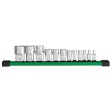
Volvo Construction Equipment is rolling out a new Fluid Analysis program. The service expands on its existing Oil Analysis program and now encompasses lubricants, diesel fuels, diesel exhaust fluid (DEF) and coolants.
This new program will equip customers to take preventive action against contamination and wear.
“The importance of fluid analysis cannot be overstated, given that early identification of these subtle patterns and anomalies can prevent costly equipment failures, minimize downtime and extend the machine’s lifespan,” said Edward Goodchild, head of repair and maintenance at Volvo CE.
Leveraging AI
Fluid Analysis is Volvo CE’s first artificial intelligence (AI) platform-driven analysis to identify wear metals and contaminants or changes in fluid conditions. The new process uses data analysis to provide reports and insights to help customers make decisions. AI accelerates the testing process, allowing lab technicians to focus on more pressing issues such as analyzing abnormal or critical samples.
The Fluid Analysis program also increases the number of testing labs to 20 global locations (four in North America) through a partnership with a testing provider. This will allow all dealers and customers of the program to utilize worldwide data, simplifying the sampling and analysis process.
Fluid Analysis
Customers can utilize the program through a service contract with their Volvo CE dealer or purchase an individual sample kit.
Once a fluid sample is taken from a machine, the dealer sends it to a lab where it is analyzed and diagnosed based on any trace elements found. A report with recommended actions is then shared on the Fluid Analysis portal and CHAIN. This cloud-based platform presents reports in a visual format.
“With routine fluid analysis and historical data, AI algorithms can identify trends, patterns and correlations that can reduce downtime by up to 15%,” said Goodchild. “This program will make it much easier for customers to reduce downtime, optimize costs and improve operational efficiency.”















